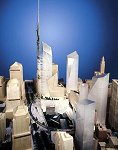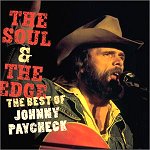| Design Chosen for World Trade Center Site | |
| http://www.sina.com.cn 2004/07/23 15:44 新浪教育 | |
语音讲解: AMERICAN MOSAIC - Design Chosen for World Trade Center Site / Questions from Nigeria About U.S. History / Country Singer Johnny PayCheck Remembered Broadcast: March 7, 2003 (THEME) HOST: Welcome to AMERICAN MOSAIC -- VOA’s radio magazine in Special English. (THEME) This is Doug Johnson. On our program today: We remember country singer Johnny PayCheck ... Answer a few questions about American history ... And report about a new design for Ground Zero in New York City. New Design for Ground Zero HOST:
On September eleventh, two-thousand-one, terrorist hijackers flew two passenger planes into the World Trade Center in New York City. Two-thousand-eight-hundred people died as the two tallest buildings in the city fell to the ground. Now officials have chosen a design to rebuild the area that people have come to know as Ground Zero. Mary Tillotson has the details. ANNCR: Design by Studio Daniel Libeskind. The winning design calls for a collection of modern glass office buildings. One would be the tallest building in the world. This pointed tower would include gardens inside. It would rise five-hundred-forty-one meters -- or one-thousand-seven-hundred-seventy-six feet. Seventeen-seventy-six was the year America declared its independence from Britain. In the center of the design is an empty space, the huge hole where the ruins of Ground Zero burned for several weeks. The design is such that every September eleventh, a line of sunlight will shine into this area as a special honor. It will shine from eight-forty-six in the morning, the time the first plane hit, until ten-twenty-eight a.m., the time the second tower fell.
Daniel Libeskind [LEEB-skind] is the architect who designed the winning proposal. Mister Libeskind says he wanted to keep the center area as a memorial to the brave men and women who died on September eleventh. A wall that held firm against the waters of the Hudson River will stand as part of the memorial. Daniel Libeskind is a Polish-born American. His offices are based in Germany. Thirty years ago, as an architecture student in New York, he watched the World Trade Center being built. Proposal by THINK Design. Officials chose his plan over a design for two tall buildings. Some thought these looked too much like the towers that fell.
The Libeskind proposal is estimated to cost more than three-hundred-million dollars to build. Officials told him that his imagination and ideas have brought hope to a city still recovering from what happened. However, planners warn that economic pressures and other issues may force changes. A separate competition to design a memorial on the ground where the fallen towers once stood will begin later this year. The Making Of A Nation HOST: Our VOA listener question this week comes from Nigeria. Oluseyi Joel Ogunbode of Osun State asks about Martin Luther King, Christopher Columbus and the American holiday, the Fourth of July. These questions are easy to answer in a simple way. Martin Luther King was a black American who led the struggle for civil rights in the United States. Christopher Columbus was an early European explorer in this part of the world. And the Fourth of July is America's independence day. But these answers do not really say much about Martin Luther King, Christopher Columbus and the Fourth of July. And we do not have the time to answer them all fully here. To get these answers, you should listen to the Special English program THE MAKING OF A NATION. It is broadcast each Thursday. THE MAKING OF A NATION answers many questions about American history. How was the United States formed? Why was it necessary for citizens to rebel against one nation -- Britain -- and create another? What is the American Constitution? How and when was it written? Why is this document still important today? In other programs, THE MAKING OF A NATION explains the rights of Americans. It tells about the mistakes they have made, and the wars they have fought. Programs describe social changes, the elections of presidents, the period of slavery, and much more. So, if you are interested in the answers to these and other questions about the United States, listen to THE MAKING OF A NATION on Thursdays. There are more than two-hundred programs in the series. And the series has just started again. Next week, it will tell about the first Europeans to arrive in what they called the New World. The story will continue each week -- all the way until the twenty-first century! Johnny PayCheck HOST: Country singer and songwriter Johnny PayCheck has died in Nashville, Tennessee. He was sixty-four years old and had been in poor health. As Jim Tedder tells us, he recorded seventy record albums and had more than twenty hit songs.
ANNCR: Johnny PayCheck was born Donald Eugene Lytle, in the north central state of Ohio. He learned to play guitar as a child. At fifteen he ran away from home and later joined the Navy. He moved to Nashville in nineteen-fifty-nine. Johnny PayCheck lived life hard. He spent two years in prison for hitting a Navy officer. Years later he recorded "Eleven Months and Twenty-Nine Days," the length of his suspended jail sentence for another crime. (MUSIC) In nineteen-eighty-five, in Ohio, Johnny PayCheck shot and wounded a man in the head. While in prison he performed with a visitor, singer Merle Haggard. Here they sing “I Can’t Hold Myself In Line.” (MUSIC) That prison term was cut short after two years. Johnny PayCheck worked hard to clean up his life. Today he is most widely remembered for a song from nineteen-seventy-seven. We leave you with Johnny PayCheck singing “Take This Job and Shove It.” (MUSIC) HOST: This is Doug Johnson. I hope you enjoyed our program today. Join us again next week for AMERICAN MOSAIC -- VOA’s radio magazine in Special English. This AMERICAN MOSAIC program was written by Jill Moss and Nancy Steinbach. Our studio engineer was Glen Matlock. And our producer was Paul Thompson. 出处:《美国之音慢速英语经典》系列光盘产品 BiCulture工作室(www.biculture.com)
| |
| 【英语学习论坛】【评论】【大 中 小】【打印】【关闭】 |



